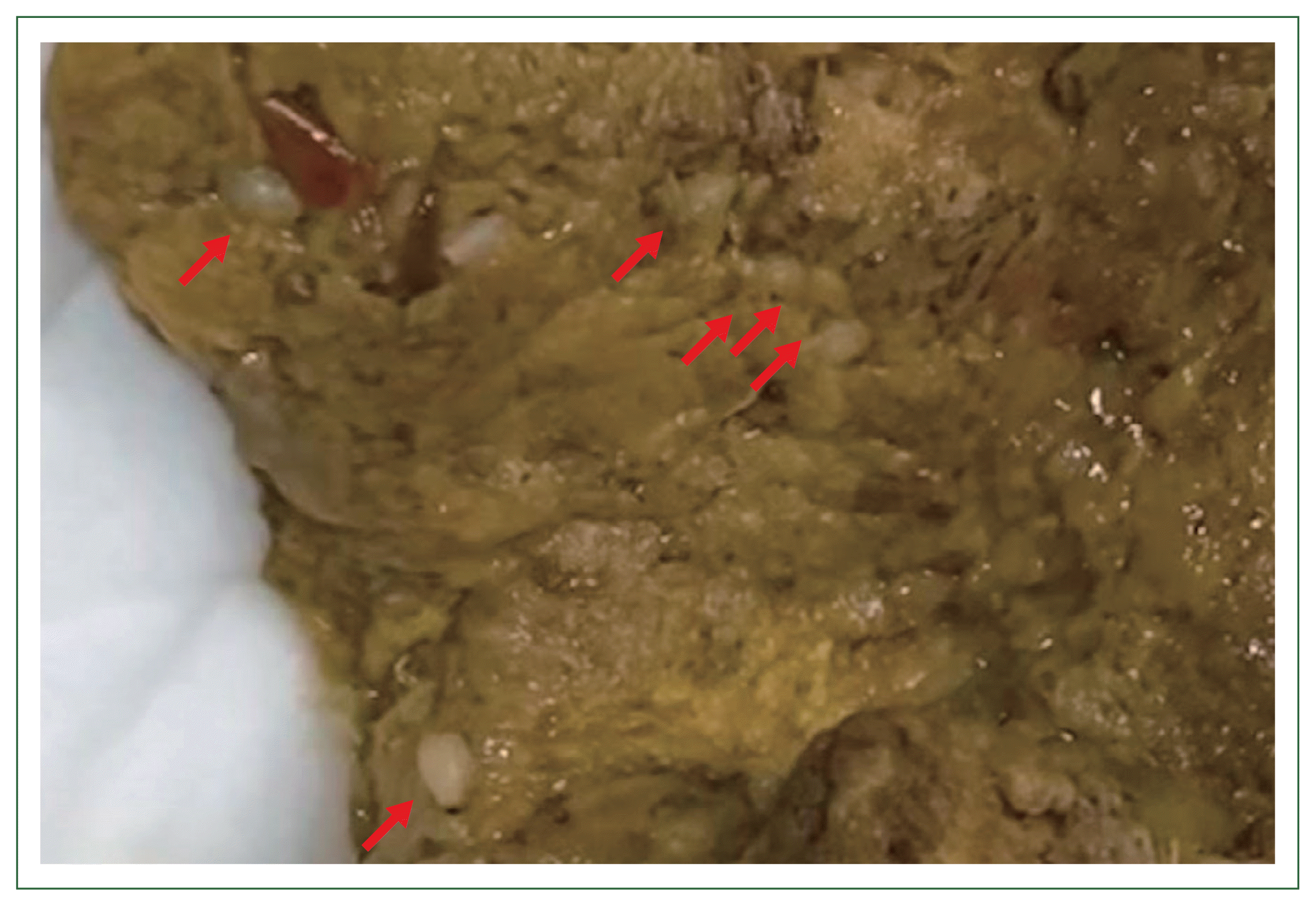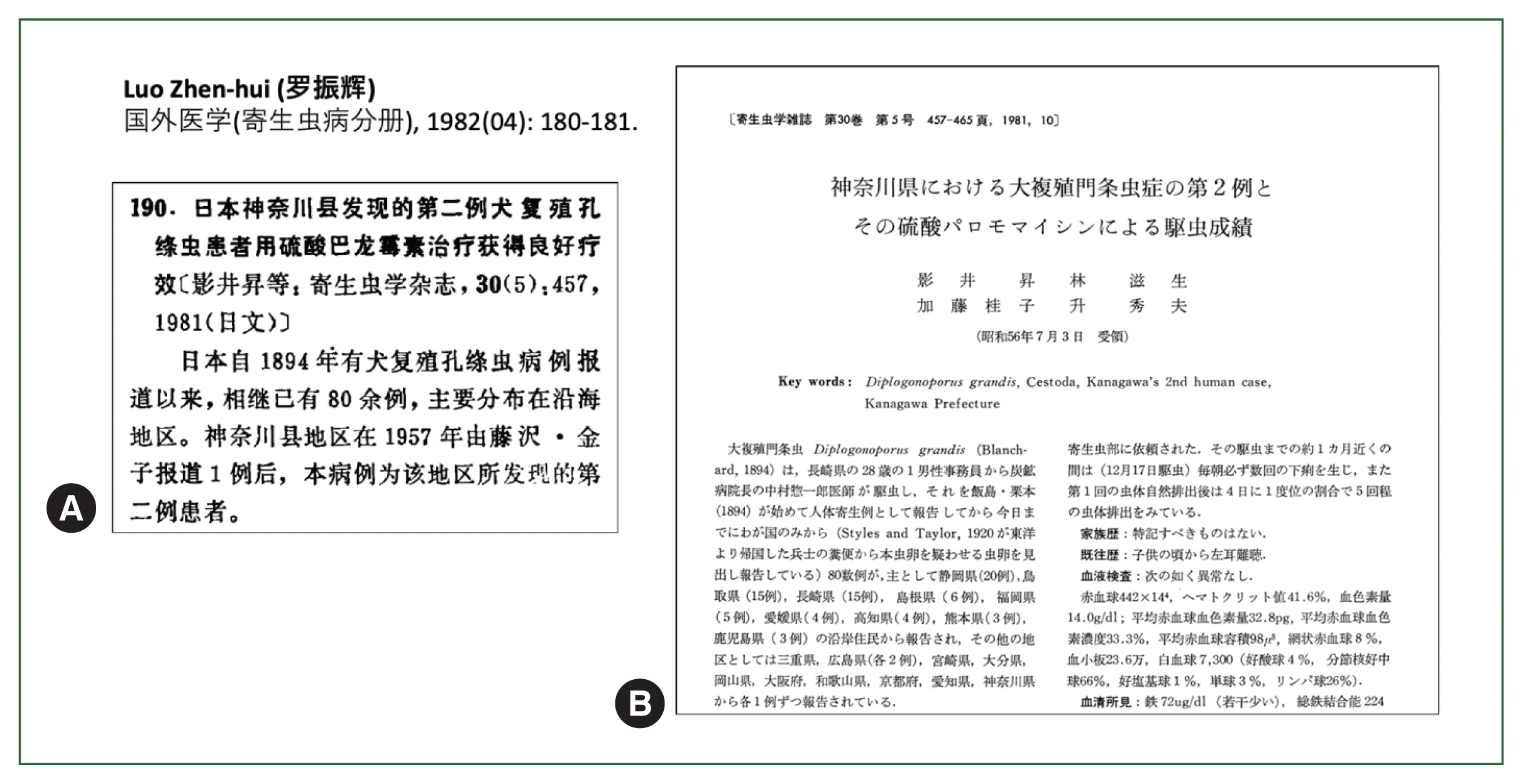Introduction
Dipylidiasis is a zoonotic helminthiasis caused by infection with a tapeworm, Dipylidium caninum, of which definitive hosts are canines and felines. Human infection occurs when plerocercoids (infective stage larvae) in dog or cat fleas or chewing lice are accidentally ingested by humans. Infection in humans is, thus, mostly seen in children, especially infants of <6 months old who have a chance of close contact with pet animals [1]. Recently, Rousseau et al. [2] made a complehensive literature survey on dipylidiasis in companion animals and humans during the last 21 years (2000–2021), and clearly demonstrated that, even nowadays, dipylidiasis is globally seen in companion animals with sporadic accidental infection in humans, mostly in children. In their review, however, nothing was mentioned about epidemiological survey or case reports in Japan. On the other hand, Jiang et al. [3] mentioned in their case report and literature survey on dipylidiasis, there are 30 cases in China and 81 cases in Japan. To solve the discrepancy of human dipylidiasis in Japan by Rousseau et al. [2] and Jiang et al. [3], we have made a comprehensive literature review on dipylidiasis in Japan.
In Japan, the first case was reported in Nagoya, Aichi Prefecture [4]. Kagei [5] made a first systematic review on human dipylidiasis in Japan with the list of 11 cases. Then, Ando [6] added 3 more cases including their own case in Mie Prefecture. However, no such review has been made since then. Thus, we have made an extensive literature survey from 1990 till now using PubMed and Google Scholar, and also Japana centra revuo medicina (“Igaku Chuo Zasshi [ICHUSHI]”). The citations in each case report were carefully checked as well. Here we report the results of our literature survey on human dipylidiasis cases in Japan to update our knowledge on this neglected zoonoses in this country.
Dipylidiasis cases in Japan–the results of the literature survey
As mentioned as above, the first case of human dipylidiasis in Japan was reported by Tamura in 1925 [4], and Kagei [5] listed up a total of 11 sporadic cases in this country, and Ando (1995) [6] added 3 more cases. After literature survey, we have found 2 more case reports since Ando’s review [6]. In addition, in May 2021, a suspected case of dipylidiasis in a child was consulted from the attending pediatrician (AF in the authors) to the web-consultation system of the Japanese Society of Parasitology about a possible self-cure of dipylidiasis, alternative examination methods, efficacy, necessity/efficacy of praziquantel, etc. The patient was a 3 years-old boy in Yamaguchi Prefecture whose mother recognized rice-grain-like moving creatures in his stool in the nappy (Fig. 1) occasionally for about 2 weeks. The mother mentioned that those creatures were apparently the same as those seen in the feces of their family cat which was under treatment for dipylidiasis. Although the patient was referred to the OPD of a regional central hospital for work-up of dipylidiasis, repeated copro-parasitological examination for dipylidiasis or other intestinal worms was negative even after administration of a gentle purgative. According to the advices from the web-consultant of JSP, the attending physician informed watchful waiting to the patient and his mother.
Thus, a total number of cumulated dipylidiasis cases in Japan up to now is 17 including the recent suspected case described above. Details of those 17 cases are summarized in Table 1 [4,7–27]. The patients are 6 males and 11 females and almost all of them are children of under 3 years old. Seven cases (41.1%) were below 1 year old. One case was a 58 years old woman who has a co-infection with hookworms [12]. In terms of geographical distribution, most of the cases, except for one case each from Fukushima and Tokyo, were reported from central to southwestern part of Japan (Fig. 2).
Discussion
In Japan, dipylidiasis still exists among companion dogs, although the infection rate is extremely low, less than 2% [28,29]. Accordingly, human dipylidiasis cases are still occasionally and sporadically found in Japan. This tendency as well as the clinical features of dipylidiasis in Japan are essentially the same as those seen in all over the world [1]. Recently, Jiang et al. [3] reported from China a case of dipylidiasis with a literature review. In their literature survey, they mentioned there are 349 cases from at least 24 countries until July 17, 2016, including 30 cases in China and 81 cases in Japan. Because the number of cases in Japan in their study and our present results were markedly different and their review did not have references/citations, one of us (YN) asked Dr. Jiang via email to share references related to dipylidiasis cases in Japan. Dr. Jiang kindly provided us a copy of the reference of Luo [30], which was a Chinese-translated digest (Fig. 3A) of the case report and a review by Kagei et al. [31] (in Japanese) of the 2nd cases of Diplogonoporus glandis infection in Kanagawa Prefecture, Japan, with the literature review of >80 cases of D. glandis infection from all over Japan (Fig. 3B). This erroneous translation had happened due to extremely high similarity of the Chinese name of Dipylidium caninum “犬复殖孔绦虫” and the Japanese name of Diplogonoporus grandis “大複殖門条虫”. Only a single tiny dot difference of the font caused misunderstanding (Fig. 4). In Japan, Dipylidium caninum is described as “瓜実条虫” which means a melon-seed-like tapeworm, which is quite different from the Chinese name of the same parasite. Fortunately for us, a few years ago, molecular taxonomic study revealed that Diplognoporus grandis is a synonym of Diplogonoporus balaenopterae [32], which is further reclassified as Diphyllobothrium balaenopterae, double-pored tapeworm of whales [33], of which Japanese name is “鯨複殖門条虫” Thus, once this Japanese name has been recognized, such a confusion between China and Japan will never occur.
As is reviewed by Rousseau et al. [2], D. caninum is a cosmopolitan parasite and distributed worldwide where pet dogs and cats are available. Nevertheless, distribution of case reports of human dipylidiasis are largely deviated to Europe and U.S.A. and far less from Asian countries. To our best knowledge, there is no case report from Korea. Like this review, there might be more cases reported in local medical journals. Collaborative research across countries is necessary to elucidate actual situation of dipylidiasis in Asia.
In terms of the clinical point of view, D. caninum infection is usually recognized first by mothers who find white rice grain-like moving creatures in the stool in the diapers of the child. Diagnosis can be made by the attending pediatricians demonstrating the typical morphological features of proglottids and/or egg packets in the stool. Praziquantel is a choice of the drug for the treatment of human dipylidiasis, 5–10 mg/kg orally in a single-dose therapy in adults. Although praziquantel is not approved for treatment of children less than 4 years old, it can be used successfully to treat dipylidiasis in children as young as 6 months (https://www.cdc.gov/parasites/dipylidium/health_professionals/index.html accessed on the 3rd January 2024).
In conclusion, dipylidiasis in humans is still sporadically occurring in Japan. Because the pathogenicity of D. caninum is generally not so serious, this zoonotic parasite might have low priority in public health. Even so, clinicians, especially pediatricians, should aware of the presence of this disease in this country and all over the world.







